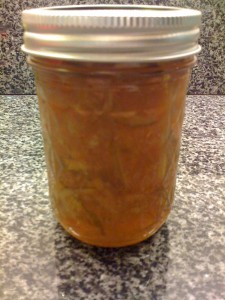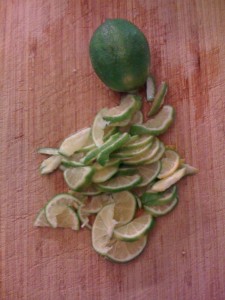When life gives you lemons, make lemonade… and when your lime tree gives you limes, it’s time to make “W” Marmalade, especially if, like me, you’re a limey!
Why “W”? Why not?! Being over-run with delicious, juicy limes, finding a little bottle of rose water in the cupboard, and then a piece of fresh ginger in my fridge, and simply because… whatever!
There’s a very subtle hint of heat, from the ginger, and little bit of India in the fragrance of the rose. You may want to raise the volume of each or either of these exotic elements, as they’re both given at their most subtle quantities. They’re simply there to add a little je ne sais quois to the lime, which for sure shines all the brighter for having these lovely friends in the mix.
It makes about 12 x 8 oz mason jars of marmalade, plus a little bit extra to spread on your toast tonight.
Ingredients:
2 1/4 lbs fresh organic limes, washed and dried
2″ fresh ginger root, peeled and grated
3 tablespoons rose water
7 cups water
3 1/5 lbs sugar
Tools:
* Serrated knife and chopping board
* Large china bowl
* Small china saucer
* A stainless steel teaspoon
* Fine grater for the ginger
* Very big saucepan, at least 10 quarts / 10 litres
* Another very big saucepan, at least 8 quarts / 8 litres
* 2 clean tea towels
* A big ladle
* Canning tongs, or long-handled utensils to hold hot jars
* Butter knife, or rubber spatula
* At least a dozen 8oz glass mason jars
Method:
1. Cut each lime in half lengthwise, and slice as thinly as possible to make half moons, removing any seeds.
2. Combine the sliced limes, grated ginger, rose water and regular water in a china or plastic bowl, and leave to rest overnight in the fridge.
3. The next day, heat the lime mixture in a large saucepan until it’s boiling, and then reduce to a simmer.
4. In the biggest saucepan, simmer the limes on a very low heat with the lid on for about 40 minutes, until the rinds are soft.
5. Preheat an oven to 350 degrees F / 180 C / Gas Mark 4, and also, put the saucer in the freezer.
6. Heat the sugar in two baking trays for about 10 minutes, stirring occasionally with a wooden spoon.
7. Measure the lime mixture into a bowl with a measuring jug. It will measure about 10 cups, but it’s important to note the exact volume.
8. Pour the lime mixture back into the saucepan, and add exactly the same quantity of warm sugar.
9. Stir the mixture over a low heat until all of the sugar has dissolved.
10. When it has all dissolved, raise the heat to high and bring to a rapid boil.
11. Do not stir at all while it’s boiling.
12. Boil on high for 14 minutes.
13. Remove the pan from the heat, and wait for the bubbles to subside.
14. Carefully using the teaspoon, put a small amount of the marmalade onto the saucer, and put back in the freezer for about 3 minutes.
15. If the marmalade seems to be a good consistency, it’s done, if not, bring back to the boil for another 3 minutes, and repeat until it’s a good consistency.
16. Meanwhile, in the smaller saucepan, in batches, boil the glass mason jars (without their lids or rings).
17. After a few minutes, remove them from the water, and leave upturned on a clean tea towel to drain, covered in another cloth to keep them warm.
18. While the jars are still hot, fill them with hot marmalade, being careful not to trap air bubbles.
19. When the jars are all filled, use a butter knife or rubber spatula to gently pull around the inside of the jars to release any trapped air bubbles.
20. Wipe the jars clean with a damp cloth, especially the tops of the jars.
21. Place the lids onto the hot jars, and screw the rings down tight.
22. Using the tongs, lower the jars back into the boiling water so that the jars remain upright, and the lids are covered with boiling water by about 4″ / 8 cm.
23. Boil for 5 minutes, and repeat if boiling batches.
24. Remove from the boiling water, and leave to cool, upright, on the tea towel.
Keep the marmalade at room temperate in a dark cupboard, or in the fridge after the jar is opened. It will be delicious and safe to eat for at least 6 months, but probably for well over a year. If it’s not eaten up immediately!
Please let us know what you think by leaving a comment...
Like this page? Please link to us and let the world know!






